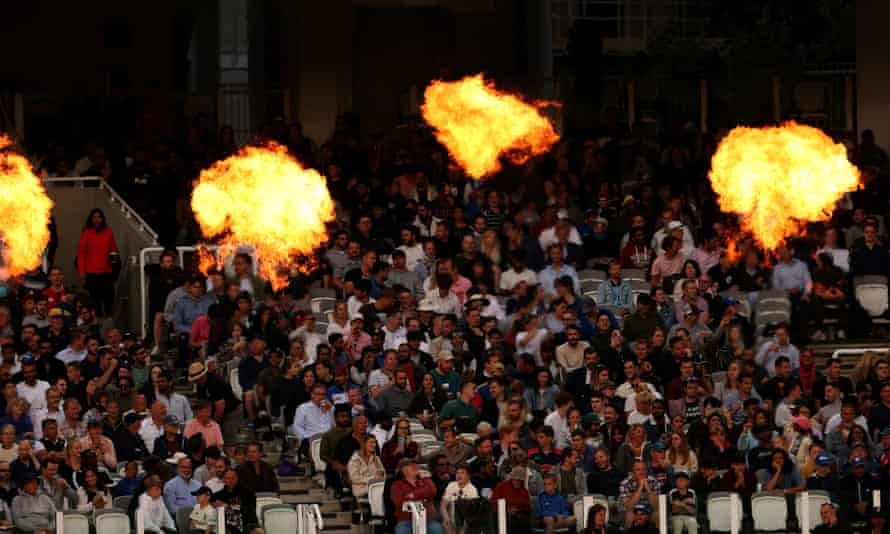[ad_1]
When I arrived in Cardiff to report on the new cricket competition, there was a problem with my media accreditation. Always me. A steward asked me to wait, adding that there were 200 people in the press box. “Blimey,” I said, “it really is popular.”
“No,” he replied. “I mean there are two people from The Hundred up there. One of them will sort things out.”
There may well have been 200 Hundred people on the spot given the money – £318m has been mentioned – that has hurled around by the once frugal England and Wales Cricket Board. But things were indeed sorted and I could watch the women’s game between Hula Hoops and Pom-Bear, which was soon followed by the equivalent male contest.
The teams do have other, official names, the home side being called Welsh Fire, led by Jonny Bairstow, whose forebears might have indeed marched fierily with Glendower had they not been Yorkies. In fact, they fielded not a single Welshman. Hula Hoops are crisps which comprise mainly thin air instead of a crunchy centre, thus making them a fine motif for this event.
At least the products advertised on the shirts are based on reality, spreading some good cheer as well as obesity and unrecyclable waste. The team names are just random word connections confected by the ECB marketing department to link their random players. But I enjoyed finding out what a Pom-Bear is and was sorry the budget did not stretch to bribing God to retime the Mancunian rain and save Wednesday’s encounter between the McCoys and the Popchips. I did catch Thursday’s game at Lord’s when Tyrrells entertained Skips: trust MCC to grab the upmarket brand.
And 10 days into the birth of this new era it is possible to divine some trends. The Hula Hoops crowd was also mainly thin air but that was because the Welsh government still thinks there is a virus going round and restricted capacity to 3,000. But the look of the crowd fitted with observations at better-attended fixtures. The Hundred has not tapped into some new motherlode of fans: the crowds look like the same eclectic mix of people who had been attending the county-based Twenty20 in great numbers since 2003. Perhaps a few more mothers and kids, enticed by the women’s matches and cheap or free tickets. But not many. And it takes place in seven different urban centres instead of 17-plus; only cricket thinks you expand by retrenching.
The game is essentially Twenty20, pared down from 120 balls to 100 as if by a sharp shower, and made more complex. This involves the return of the five-ball over, after 132 years, hailed by the ECB as an idea of staggering genius. It makes little difference to the paying spectators except to confuse them: few people watch mini-cricket that closely barring a tight finish; and the Cardiff scoreboards were too full of eye-catching crap to mention the score that often.

Of the gimmicks, nothing original was good and nothing good was original. The Olympics have been scheduling men’s and women’s events together since 1900. The sub-baseball fripperies involved a total misunderstanding of how baseball works: the sideshows are always at one with the play. And why employ dancing girls if you’re targeting mums and kids?
One of the problems is that the ECB has been so arrogantly opaque at explaining its objective. It has pumped out propaganda: endless press releases trumpeting the Hundred, written in a style best described as “artificial unintelligence”, ie by young employees who have to write stupidities because it beats working for Uber. The BBC amplifies this with its inane and craven part-time coverage. Engagement with sceptical cricket-lovers? Forget it.
In this vacuum two explanations circulate. One is money, but they are spaffing that. The other is power. Andy Nash, a former board member who went rogue, is certain of that. It fits with the long-term ECB objective of accreting power. “What they are doing is leading to the strangulation of county cricket including Twenty20, and with it English cricket,” he says. “These teams have no roots in their communities and will develop no new players. They bet the farm on this, relying on market research. If market research worked, nine out of 10 new products wouldn’t fail.”
And this one was never test-marketed. Immediately, it sprawls across the short high summer like a wolfhound hogging a small sofa. The cricket season was already a shambles with three different forms of the game. Now there are four.
With internal opposition routed, one senses that groupthink has taken over Lord’s, of the kind that gave the world New Coke, the Austin Allegro and the Iraq war. At the ECB itself, one can add the infatuation with the no-goodnik tycoon Allen Stanford (now serving 110 years) and the decision to abandon mainstream TV 16 years ago, which it is now trying frantically to reverse using the BBC to shill the Hundred.
The Spin: sign up and get our weekly cricket email.
The money theory rests on it having trademarked the name, thinking the cricketing world will forsake Twenty20 and pay for this. An early response came from one influential Indian, the former captain Sunil Gavaskar, who pronounced the format “insipid”. He could have added “insensitive”, “insulting”, “insane” and potentially “insolvent”.
Meanwhile three troubled entities are locked together in a dance of death: the ECB, the rotting hulk of the degraded BBC sports department and the junk food industry, running out of road with TV advertising and joining forces with cricket – just as the game depended on the John Player League and the Benson & Hedges Cup in the dying days of tobacco advertising. C’mon, you Popchips.
[ad_2]
Source link